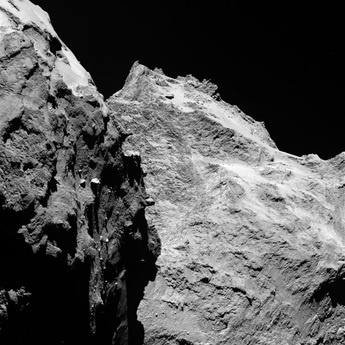
The comet is around 4 km (2.5 miles) in size, and is essentially a 'dirty snowball' comprised of water ice and dust. The spacecraft has an array of cameras which have been busy producing high-res images of this amazing object, and pictures taken in September show that the comet is beginning to produce active outgassing/jetting as it responds to the increasing heat of the sun.
The content of the majority of this post can be found in the 'Picture gallery' page of this website, which shows 12 recent images from the Rosetta spacecraft showing a variety of features of the comet nucleus. During mid-September images were taken for the purpose of selecting the primary landing site for the Philae lander, and as an outcome of the process 'Site J' was selected as the primary landing site (see Images 4 and 9), and 'Site C' and the backup (see Image 5). The criteria for choosing Site J were to minimise risk to the lander, while still being scientifically interesting - for example images have shown signs of outgassing activity nearby. In terms of minimising risk, the majority of slopes in the neighbourhood are less than 30 degrees, and there are few boulders. The site also provides sufficient solar illumination to provide necessary electrical to the lander's systems.
Finally I should of course acknowledge that all images are courtesy of the European Space Agency.
 RSS Feed
RSS Feed
